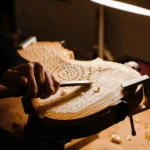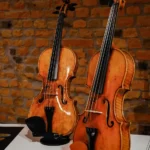Stradivarius Cellos: Pricing, Craftsmanship, and Investment Insights
Back to BlogThe Cello’s Unique Role in Classical Music
Classical music would not be what it is today without the cello. The cello makes a beautiful, rich singing sound, which, out of all stringed instruments, is the one that sounds most like the human voice. Due to its large size, the cello has a lower range than a violin or viola, and therefore, for centuries, it rarely got to play the tune in a symphony orchestra. Thankfully, composers eventually discovered its beautiful voice and started writing works in which the cello takes center stage, creating exceptional sonatas and concertos.
Stradivarius Cellos: A Legacy of Excellence
Antonio Stradivari handcrafted nearly 80 cellos in his lifetime. He pushed the boundaries of design and sound, making cellos with a broader range of expressiveness and power of tone, creating an original design unmatched in previous cello making. His cellos are regarded as the finest ever made and highly prized due to their superior tonal qualities and perfect craftsmanship. Owning or playing a Stradivarius cello is any musician’s dream.
Antonio Stradivari: Master of Craftsmanship
Antonio Stradivari was born in Cremona, Italy, in 1644 and began his stringed instrument apprenticeship at a young age under the influence of Nicolo Amati. He built his reputation as a fine maker by selling instruments to royal families and notable citizens. Renowned for his precision and artistry, Stradivari’s instruments are celebrated for their exceptional quality. Every creation reflects his meticulous attention to detail, resulting in instruments known for their unrivaled tonal richness, brilliance, and projection. Stradivari has profoundly influenced the world of stringed instruments, and his legacy continues to resonate, shaping the tradition and style of fine instruments across generations. Musicians, collectors, and artisans draw inspiration from his work, making Stradivari’s legacy a testament to the enduring artistry of stringed instruments.
Cellos, built by Antonio Stradivari, has a special mystique in the classical music world. He is credited with several design innovations and refinements that helped bring stringed instruments to their modern form. Stradivari was considered a master craftsman in his own time and the following decades, but his reputation as the best solidified only in the early 19th century. Of course, Stradivari’s cellos are sought after for their historical value and visual beauty. They are also considered by many to be musically superior to any other cellos, having brilliance, depth, and character unlike anything else.
Italian Craftsmanship in Cello Making
Italy has a long tradition in cello making, which dates back to the 16th century when significant luthiers in Cremona and Brescia dominated the market. At the same time, luthiers were generally foreigners from Northern Europe in various other Italian cities. Among the most important were Platner, Sellas, Tecchler, and Goffriller. Bologna in Italy was one of the most important centers for developing cello music; it was the first city to produce wound gut strings. The country’s tradition continues to this day, and Italy is undoubtedly one of the most important exporters of fine-stringed instruments and home to the greatest cello makers.
The craftsmanship of Italian luthiers is considered the best in the world. The tradition of cello-making began in Italy, and therefore the techniques of craftsmanship have been passed down generations. For a modern-day luthier, living in a country with a strong tradition in stringed instrument making is definitely inspiring as they can walk in the footsteps of the master makers of the past.
Why Classical Cellos Are So Valuable
Classical cellos are valuable for many reasons, and their price can often be in the millions of dollars price range. Since genuine antiques are steadily decreasing in number on the open market, their value will only continue to increase. This means that buying one of these instruments is an excellent investment. In addition, their sound can be richer than a modern cello’s sound since it is already well developed from the time of playing. This is because stringed instruments, just like wine, build their sound with time and play. So, the more you play, the better it gets. Over time, the varnish on a classical cello may change in appearance, and many historical enthusiasts will appreciate this aging process.
For these reasons, classical cellos often attract musicians and collectors. Not only will a musician produce an excellent sound on one of these instruments, but they will also feel connected to the historical heritage of such a cello. Imagine these kinds of cellos like a famous work of art because, by all means, they are one! Many antique cellos are owned by museums or played by famous musicians; their value and importance are limitless.
Stradivarius Cello Pricing Factors
Only 63 cellos made by Stradivari currently exist. This makes them rare enough to be sometimes more valuable even than his violins since there are more of those available. Considering the rarity of his cellos, the price of them is obviously going to be very high, especially because Stradivari is considered the greatest maker of all time.
Regarding Stradivarius cellos, different factors will influence the price of the instrument. First of all, the overall general condition of the cello: if it has been kept in top condition, it will be worth more than one that has not been well preserved. Another factor is the history of the instrument, including the history concerning who owned it, who played it, etc, and when it was made. A cello made during the Stradivarius golden period will be worth more than one made in a different period. The overall sound quality of the cello can influence the cost as well. Lastly, an important factor to consider is that the market for fine-stringed instruments has been hitting high notes over the past 20 years, as the prices have been going up exceptionally, making this kind of asset an excellent investment.
Famous Stradivarius Cellos in History
Stradivarius cellos are owned by museums, institutions, musicians, and private collectors worldwide. Some of history’s most famous Stradivarius cellos are the 1701 Servais, the 1711 Duport, the 1710 Gore-Booth, the 1714 Batta, and the 1712 Davidov. All of these cellos were made during the golden period of Stradivarius when he was at the peak of his craftsmanship.
The 1701 Servais
It is a magnificent instrument of incredible visual beauty currently owned by the National Museum of American History in Washington, D.C. Adrien-François Servais is the Belgian cellist who owned it for over two decades and helped preserve its original grand dimensions. Servais acquired this cello on a trip to Russia from Princess Youssoupova for an important concert before Tsar Nicholas I. Servais almost lost the instrument once during a sled trip across the Russian steppes. Still, the instrument was found the next day lying in its case in the snow: the leather binding of the case had been bitten by wolves. Nowadays, the Servais is primarily played by Dutch cellist Anner Bylsma.
The 1711 Duport
It is one of Stradivari’s ‘B Form’ cellos, which arose from patrons’ requests for a smaller, more versatile cello that took advantage of recent advancements. Most likely, this cello was built at the request of King Louis XIV’s personal physician, François Chicoyneau. When he died, it was put up for auction and was bid upon by Cellist Jean-Louis Duport, but the auction failed and was eventually entrusted to a private dealer, George Cousineau. Duport was later contacted to see if he was still interested, and he bought it at a relatively low price. In 1812, Duport permitted Napoleon Bonaparte to handle the cello after giving a concert; a dent, still visible on the instrument, is said to have resulted from the emperor’s rough handling while straddling the cello with his boots. The instrument was owned and played by cellist Mstislav Rostropovich for many years.
Owning a Classical Cello: What to Know
Acquiring a classical cello is a big investment that you must go into being well informed about. Research is key here, as you must know exactly what kind of instrument you are looking for and your ultimate goal (will you be playing the cello? Reselling it? Keeping it as a collector’s item?). Once you have determined these factors, look for trusted retailers that can help guide you in making the best choice. Ensure the cello has been appraised and that its condition is accordingly. If you plan on playing it, try it out to ensure it feels right for you.
➡ Explore our curated collection of fine cellos available today.
Tips for Maintaining a Valuable Instrument
Older instruments may be more sensitive to weather changes, especially humidity. That is why it is very important to maintain proper humidity levels between 50% and 60% around these instruments to avoid damage. A classical cello will also need to have more regular checkups done by an expert luthier. Just like an antique car, these kinds of instruments need to be regularly checked on to make sure they play at their best and do not get damaged. Never forget to wipe clean the cello and bow with a soft, clean, natural-fiber cloth after playing to remove dirt and excess rosin. Remember to have your cello regularly rehaired during its check-ups by an expert.
➡ Learn about how to take care of string instruments by our expert master maker Luiz Amorim.
Conclusion: Why Stradivari Still Matters Today
In conclusion, we can say that Stradivarius cellos are probably the best cellos in the world. They not only have extremely important historical significance, but they also sound and look beautiful. This makes them an excellent investment for any musical enthusiast; whether they plan on playing, reselling, or just collecting this kind of cello, the value will only increase over time. However, the budget, time, and care necessary for owning one of these instruments are not available to everyone. Therefore, a classical cello like a Stradivarius may not fit some people best.
For those who cannot own one of these masterpieces, it is nonetheless still extremely important to know and learn about them. Luthiers will study them extensively to create copies or just be inspired by this kind of cello, musicians will listen to their sound to try to emulate it while playing, and musical enthusiasts will find joy and inspiration in seeing such beautiful instruments. Even those who do not know much about classical music will be amazed by these beautiful, historical masterpieces and appreciate the exceptional craftsmanship that was used to make them. Continuing to share information about Stradivari and his extraordinary cellos is important to keep his legacy alive and thriving.
If you’re searching for a cello with tonal depth, historical resonance, and exceptional craftsmanship, book a private consultation with our team today.
➡ Discover how we create faithful copies of historical instruments.
About the Author and Workshop
This article was produced by the editorial team at Amorim Fine Violins Cremona, a family-run workshop established in 2001 by master luthier Luiz Amorim. With decades of experience crafting, restoring, and authenticating fine violins, the Amorim team serves musicians, collectors, and institutions worldwide. We are committed to ethical expertise, scientific precision, and a passion for preserving musical heritage.









